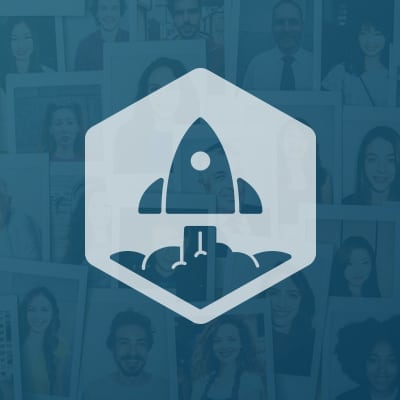The implications of growing from nothing to $20 million ARR are immense. You’ve reached an incredible milestone, but what changes must your organization make in order to continue growing? How should you look to the future? For one, you tend to want to sell to anyone will buy your product in the early days, but by the time you hit $20 million ARR, you’ll have learned which areas to focus on to maximize your ROI.
Jason Green, Founder & General Partner at Emergence Capital, sits down with Scott Berg, COO at ServiceMax; Katy Keim, CMO & GM at Lithium Technologies; and Godard Abel, SVP & GM at Salesforce Quote to Cash, to discuss going upmarket, M&As, breaking into big companies, how landing and expanding can take you to the next level, and why planning things ahead of time is so important.
With all three panelists having built amazing companies from $0 to $100 million ARR not once, but twice, we can certainly learn many valuable lessons from Scott, Katy and Godard’s experiences.
And if you haven’t heard: SaaStr Annual will be back in 2018, bigger and better than ever! Join 10,000 fellow founders, investors and execs for 3 days of unparalleled networking and epic learnings from SaaS legends like Eric Yuan, Tomasz Tunguz, Chris O’Neill, and Mikkel Svane. If you don’t have tickets, lock in Early Bird pricing today and bring your team from just $799! (All ticket prices go up October 1st.) Get tickets here.
TRANSCRIPT
Announcer: He’s invested in leading SaaS companies such as Box, Yammer, EchoSign, ServiceMax, SuccessFactors, and Gusto, just to name a few. Please welcome three time SaaStr Annual speaker, Founder and General Partner of Emergence Capital, Jason Green.
Jason Green: It’s thrilling to be here for my third SaaStr Conference in a row. Jason Lemkin has done an amazing job building this community, and we’re thrilled to be part of it.
We had an amazing party last night, the Peas and Pods dinner at the Press Club. I apologize for folks who tried to come and we didn’t have enough space for them. Next year, we’ll get a bigger venue. It was quite an impressive turnout.
Emergence, as many of you might know, has been focused on SaaS since we got founded back in 2004. We’ve been 100 percent focused on SaaS since that time.
I’m proud to say today, we still live, breathe, and bleed SaaS. We’ve been both very, very lucky to have had participation in amazing companies.
Peter Gassner here earlier, we were the early round investor, ServiceMax, Yammer, Box, and others. Today is an amazing opportunity to learn from three folks that we’ve had the pleasure of working with now for close to a decade each.
I’m calling this the $600 million panel because each of these panelists has built SaaS companies from 0 to 100 not once, but twice.
There aren’t that many executives that have had that experience, and to have three simultaneously together to talk about this today is very special. What we’re going to be digging in on is post product market fit. What are the challenges that companies start facing when they hit that $20 million ish ARR and they’re trying to get to $100 million?
I’d love to quickly introduce the panelists here and give you a sense of their background. Scott Berg, to my right, is COO of ServiceMax, now part of GE, and was at ServiceMax for almost eight years.
It was a long run there, has come up through the sales executive discipline, and was at SuccessFactors, which is another investment of ours early on, so we’ve gotten to work with Scott twice now, which is wonderful.
Katy Keim, to his right, is CMO and GM at Lithium Technologies, another great portfolio company, has been there for now almost seven years, and at ServiceSource before that for five. She’s seen two companies, one go public, and now Lithium, which is still private, but doing exceptionally well.
We’re pleased to have her, and then Godard Abel from now Salesforce, but formerly of SteelBrick, which we were lucky to be first round investors in, and also Founder and CEO of BigMachines, so he’s done it twice as well.
Welcome to the three amazing panelists. Thank you for sharing your time today, and I’d love to start out just at a high level because it’s pretty rare to have people who’ve experienced the inside of two very successful SaaS businesses.
Maybe you could just for us try and capture a little bit of the essence or the magic of what made those companies special. You now have a pattern recognition that a lot of folks don’t have.
Scott, we sold ServiceMax to GE just recently for $1 billion. That was an amazing outcome, a great one for the company and for the investors, and hopefully for GE going forward, and you were there again, since pretty much 2009.
Scott Berg: Yeah, almost day one.
Jason: Tell us about that journey, and what you think made that so special.
Scott: As I think about the last two companies, both ServiceMax and SuccessFactors, I use the analogy with a lot of people that I like to get involved in things that I can explain to my parents.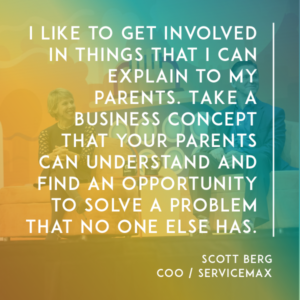
What that really means is that you take a business concept, a function that most companies have. Your parents can understand that function, and you, I guess, get lucky enough to find an opportunity to solve that problem that no one else has solved.
I think both at ServiceMax and SuccessFactors, you find yourself in the early days sitting in companies like that saying, “I can’t believe nobody’s thought of doing something about this. It’s too big of a thing. We’re gonna go do this.”
The combination is a good business problem you can solve that you can articulate well, and being early on in that moment where you can say, “We’re gonna go after this before anybody else notices that there’s a big opportunity here.”
Jason: Peter Gassner was on earlier, and he talked about the fact that he likes it when 99 people out of 100 tell him, “This is a stupid idea.” It means he’s onto something. Do you agree with that assessment or do you think…?
Scott: I totally agree with that. You can look at SuccessFactors and say, “Performance appraisals? Come on, really?” Look what happens to human capital.
If you can look at field service, you’d say, “The guy’s fixing things like the cable guys at my house? No, no, no. Wait, listen. There’s more to this story.” I agree with Peter.
Jason: I think one of the things I appreciate about both SuccessFactors and ServiceMax is they took a very non sexy application, and they made it very sexy by building an amazing company, so congrats on that.
Katy, you’ve been part now of two great successes, ServiceSource which went public, and Lithium which we hope will be public soon someday.
[crosstalk]
Jason: [laughs] Tell us what do you think the magic of those two companies was, what were maybe some commonalities or threads there.
Katy Keim: I think I netted it out to two really practical things. One is a really focused go to market. We can talk a little bit more about it but when you get that knee of the curve, I think you’re trying to go from opportunistic to intentional. For me, both those companies just showed up in the machinery of the go to market.
The second thing is awesome unit economics. When you have something that you’re pulling through an engine and you understand how much it costs, where the growth is, how the other implications of the chain need to be played out, and then you can repeat it, that’s where you really start to see that exponential growth between 20 and 100.
Both of the companies that I’ve been at had a really good fundamental understanding of that.
Jason: What do you think contributed to that awesome unit economics? Was it the kind of companies that they were going after, the price points? What do you think?
Katy: Let me start with ServiceSource. ServiceSource was a service driven business and many would say, “Hey, it was just a contact center business that was perfected.”
The way that we perfected it was a Six Sigma approach to how we hire talent, when they start to hit their maximum productivity, what the margin is per the people on there, and then how technology was going to help build the profitability of the account. The way to compete in that market was just be damn, damn good at the operations. The unit economics made sense there.
In Lithium, it’s been a little bit different. There’s a focus in the SaaS industry all about customer acquisition, logo acquisition, logo acquisition, but I think Lithium understood very early that great customers and cohort growth was really the driver of their financial engine, more than just churn and more than just expansion.
It was like, “These customers will be these kind of relationships over the longer horizon,” and we built the business around that. Those are just more specifics.
Jason: Super. Great. Godard, you started BigMachines. You bootstrapped that business for many years before taking some outside capital. That was like a 10 or 11 year run, sold to Oracle, ultimately.
With SteelBrick, you compressed that 10 years into two. Tell us, what was the difference between [laughs] that 10-year and 2-year experience? Also, an amazing outcome in a very short period of time. What did you learn between that first and second?
Godard Abel: Thanks, Jason. First of all, good morning. So great to be here with all of you and see a lot of SaaS entrepreneurs. John Stewart from MapAnything and many of you.
In terms of the first time, BigMachines, it was a long arduous struggle. I think you said it’s a good idea if 99 out of 100 people tell you you’re wrong. We started BigMachines way back in 2000, it was still dot com era.
But I think by 2002, 100 out of 100 customers were telling us it was a bad idea because we were helping companies, frankly, like GE that made BigMachines, move that online with a SaaS application and try to help them sell like Dell.
I do remember actually GE…we always joked about it, I think it was like a 10 year sales cycle, we first called on them in 2000, but it was just very hard environment then for SaaS companies. In fact, it was so much harder to build a SaaS company that we had to build our own hosting and all of that.
The thing that carried over is we persevered and we just built a great team, a lot of that team including Matt Gorniak and you know our team, we really learned together, gelled together, persevered.
The second time, the market, the environment was much better but we also had the team totally dialed into the opportunity and so we were able to do it 5 to 10 times faster.
Jason: You had the unfair advantage of having brought the band back together the second time round.
Godard: Indeed. That’s also the fun of it to me. We talk about our heart of the brick culture but it’s through that heart in the team and struggling every day together and ultimately winning, that’s what I love doing.
Jason: I’m curious because a lot of entrepreneurs start one kind of company and they want to do something completely different just out of pure curiosity of trying something new. You went after the same market to some extent with a different product and go to market strategy. Tell us about that decision. Was that intentional or more opportunistic?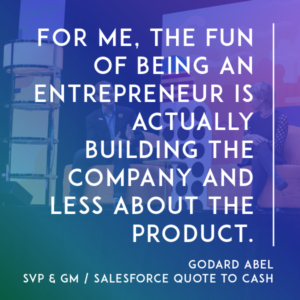
Godard: I think it was intentional. One, we still love the market but I think more to me, the fun of being an entrepreneur is actually building the company and maybe less about the product. But just turning all the dials, aligning all the people, and really winning together.
The opportunity to take a dialed in team, do the same thing but do it much better really got us all pumped up. It was a lot of fun.
Jason: We’ll get more into building the company later, because I think that all of you have really, not just built great products but built great companies.
I’d like to transition to a little bit more, the next layer down granular, of what it takes to build a $100 million SaaS business from 20.
Let’s start with sales, because without sales, really there’s nothing else that really matters. Building an effective go to market sales machine, and also we talked a little bit about customer segmentation. At about $20 million, my sense is most of you have had pretty good discipline about picking the spaces you wanted to compete at.
Scott, maybe we’ll start with you, talk a little bit about…ServiceMax had, if I remember, six straight years of 100 percent year over year growth. Tell us how your thinking evolved in terms of customer segmentation and building that sales machine.
Scott: I guess, speaking from my experience there, I think early days of it, it was an interesting turning point, pre $20 million and post $20 million. I think in the early days, you’ve got such a horizontal appeal on the solution, at least that’s the way we viewed it, that we wanted to sell it to everybody that would have it, that we had our sights set very, very wide on the market.
We ran, actually, separate sales teams for what we called small biz, and the mid market, and then the large enterprise. We later added a strategic team, so we casted a really wide net.
As we started to cross $20 million, we started to look at the unit economics, I think as Katy would call it, and think, “What are we really good at? Are we gonna get to where we wanna be on $20,000 annual contracts or $200,000 annual contracts?” I remember we were budgeting, picturing $1 bill and saying, “Do I put it here, or do I put it there?”
For the first five years, I tore it into three pieces and placed it, [laughs] and then after about $20 million, as you know, Jason, we put a bit of a stronger focus on the, what I would call upmarket.
Middle market, enterprise to strategics, that’s really what we knew we were good at, that was the sales cycle that we knew how to close, and that was an ROI for us and our customers that made sense. The discipline refined, I think, as we crossed 20.
Jason: In retrospect, do you wish you had never tried the SMB business or was that super important to getting the engine going early on?
Scott: No, I think it was really important early on. I can remember that the energy and company and still to this day, we talk about logos, how many logos did we do? Now we’re in, obviously, revenue and GAP revenue and GE budgeting, and all these fun things now, but there’s still this great passion about logo acquisition. I think that’s one thing, as momentum play.
I think the other thing is that we learned a lot from those customers, and they learned a lot from us. A lot of them turned out to be some great growth stories, they’ve been featured in CFO and Fortune as really phenomenal growth small companies.
I’m glad we did it and I’m glad for the momentum, but at some point, you do have to, we chose anyway, to focus…
[crosstalk]
Jason: To de-emphasize it.
Godard, you guys also equally had an amazing track record of beating your numbers every quarter. I remember on the board, I think seven quarters in a row, every time you guys beat your numbers. I think that’s continued at Salesforce, post acquisition.
How did you do that? How do you build in that kind of discipline and consistency into a sales team?
Godard: It is now 12 quarters in a row.
Jason: Congratulations.
Godard: A lot of that is, I think, thanks to Matt Gorniak, who’s my business partner and also our sales leader, our CRO. I think, over the years, that’s one of the things we learned at BigMachines the hard way, where there were years where we were only doing two deals, frankly which was really painful. We really had to focus on how do we make this sales process fly.
I think it took us about 10 years at BigMachines where we developed…and we did use Salesforce, where I’m now proud to work. We did put everything, a lot of discipline around the pipeline, frankly using our own CPQ but also really having a system and a method that the whole team buys into.
Matt then built the great second level of sales leadership. He built the whole sales playbook, and we keep evolving that playbook. It’s just nice to see it gelling now.
The other thing is just a belief, and Matt always…I think he has a great expression. He always says, “Hey, there’s no Plan B,” so just that total commitment. “Hey, we’re gonna hit it and beat it,” and it’s just awesome to see it working.
Jason: How do you guys think about planning for sales? Peter Gassner was here earlier, talking about…he thinks about it when he started, on a quarterly basis, now they have three year plans. How far out were you thinking about building your sales capacity in Machine, as opposed to just hitting the numbers for the quarter?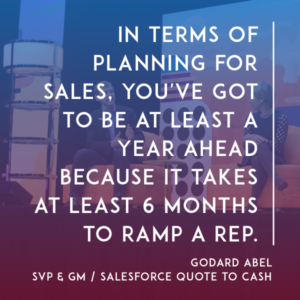
Godard: In my mind, you’ve got to be at least a year ahead, because it does take, we all know, let’s say six months at least to ramp a rep, really.
The way we always did it was, frankly we add up who’s on the team and we know, “OK, Jason can do two million, and Bob can do 1.5.” We do both top down but we need to do a bottoms up sanity check to know, “Hey, here’s what I need from each region, from each team member.”
Obviously, thinking a year ahead, “Hey, if we wanna grow 100 percent, 200 percent again next year, how many more do we need to hire so that next year, we have the names that can drive the revenue?”
Jason: Katy, you talked about the importance of customer unit economics earlier, and one of the things that we believe deeply at Emergence is the essence of a great SaaS business is what we call Land and Expand, selling more into your existing customer base.
Tell us a little bit about that philosophy, how you’ve applied it, both at ServiceSource and Lithium, and any lessons learned from that front.
Katy: I think both the experiences were really similar, in terms of the Land and Expand, how we did it, but what’s interesting is they were in very different markets. One was a replacement market, and Lithium’s really an emergent market in social. I love the predictability of quarters you guys had, makes me sick.
[laughter]
For the rest of us that are forging new categories, we don’t quite have that machinery, we have a lot of ambiguity in the sales cycle, etc., and so Land and Expand really becomes a way to kick a door open.
When you’re trying to convince a buyer that what they’re about to do, is that 1 in 99, I prefer better odds than 1 to 99, I’d like it to be 15, 20 at least, to the 85.
When you’re going in to tell a buyer like, “The way that you’re doing things won’t work in the future, and the world is shifting underneath your feet, and here’s what the picture of tomorrow looks like,” that’s risky.
I think, sometimes when we think about it just from an economic and from a sales perspective, we aren’t thinking about the psychology of the buyer, which is, “This has too much risk,” not to say no to you, but to actually do nothing. Do nothing in the sales process is the killer.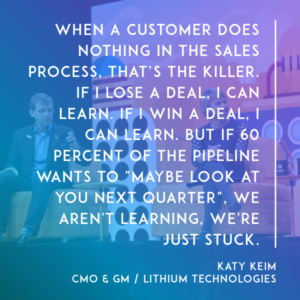
If I could get a deal lost, I could learn, and if I could win, I could learn, but if pushed, 60 percent of the pipeline opportunities to, “Hey, we might look at that next quarter,” we aren’t learning, we’re just stuck.
Land and Expand became a way for us to kick the door open and prove ourselves, not just from an economic perspective but to get the buyer comfortable like, “Hey, I am gonna be someone that’s gonna be moving the needle in a new way in the organization.” We’re often helping that buyer sell it into their own business, which is what’s really creating the expansion opportunity. They need help doing that.
I would say Land and Expand…but the other dynamic that’s going on with us from $20 to $100 million, I’m sure you guys are struggling with this, is that those first deals are not what you want your TCV to look like three years from now.
Jason: Ultimately.
Katy: ServiceSource, when I first started, we were doing $400,000 contracts. We were about $5 million when I left. Lithium, it was a $75,000 ACV. We’re in the multi million if we do big deals with big brands.
There’s a healthy tension in the company between big deals and landing…whale hunting and kicking the door open. We could probably spend an hour on that but we definitely struggled with how to do that.
Jason: Did you intentionally think about, “Every year, we want to double our ACV per customer,” or how did that happen? How important was that?
Katy: Certainly, sitting in the marketing role, I was thinking about that. Sell higher. Doubling your ACV is not just a sales thing, it’s the message, it’s the caliber of the sales organization, it’s the training, it’s the playbook, it’s who you’re calling on.
It’s a function, but clearly it gets led by the mentality of the sales leader, and my CRO who I work with now has great experience in doing whale team deals, and so that clearly has moved us along that journey faster.
Jason: Scott, ServiceMax was selling to the largest industrial companies in the world in one of the most conservative segments of those companies, the service organization.
You’re selling the platform of record they’re running their business on. How do you break into a GE, to a Siemens, to a Schneider Electric as a small company that most people have never heard of? Tell us about that.
Scott: I guess my history, most of the time I’ve been at ServiceMax, I was the sales leader, so it’s personally tormenting to know whether to take the pilot or go for the big deal. Take the pilot, go for the big deal, especially with investors putting some pressure and trying to get those revenue…
Jason: Good pressure, though, right?
Scott: Good pressure.
Katy: It depends where on the quarter this happens, as well. [laughs]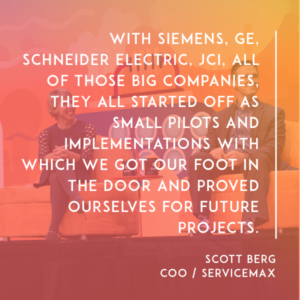
Scott: Exactly. I can tell you in every one of those examples you listed, a Siemens, a GE, a Schneider Electric, a JCI, all of those projects, I would say in 20/20 hindsight now, started off as small pilots, small implementations where we could get in and prove ourselves.
Everybody always talks about SaaS as people are renting it, so they have to renew. There’s a lot of focus around customer success, but I would say even before that happens is people don’t really pay for stuff that doesn’t work. I don’t care what they’ve signed. I think one of the things we’ve always stayed true to is you’ve got to make that customer successful.
If that means one operation in Japan, you should go do that. After that, the conversation about price points and contract commitments is a hell of a lot easier than it is before neither one of us truly believes in each other.
Jason: Did you worry too much about pricing or the magnitude of what they would ultimately commit to, or was it just, “Get your foot in the door”?
Scott: I think it’s get your foot in the door. I think in hindsight, maybe I wish we’d worried a bit more about pricing, because you do tend to give away the big deal priced on the small deal up front. We’ve gotten a little bit more disciplined about that but our CFO three years ago, I think, started this concept of a cohort type analysis.
I know you’ve seen it, but what was the class of 2000 ServiceMax customer? What did they pay back then, and what did they pay us in 2016?
When we finally, a few years ago, realized that these were 300 percent, 1,000 percent growth over a span of two, three, four, five years, you really had a sobering realization that it was important to get your foot in the door, make a customer successful, and this tends to work itself out if we can have that first moment.
Jason: We’ll talk a little bit about growth and efficiency, but the unit economics of going after those early pilots aren’t so obvious. Right?
Katy: [laughs] No.
Jason: It is a challenge as a company to make that investment, but clearly when the upside is there, in terms of the potential for that deal, it was certainly worth it in ServiceMax’s case.
Let’s transition a little bit to the marketing side and building leadership in your category. Katy, this is an area that you’re certainly world class at. How does marketing investment and strategy or tactics change between 20 plus?
Clearly, early on you’re doing whatever you can to get the company’s attention out there, but what strategically, things like the magic quadrant or your own customer conference. What things have changed as you’ve passed this threshold?
Katy: It’s funny. You even prepped me for this one. I was just like, “Ah, there’s so much there.”
I think the biggest challenge that marketers have is category creation. You can throw in the kitchen sink. [laughs] Marketers love to do that. I’m guilty of that, too. “Well, we’ve got to do analyst. We’ve got to do PR. We’ve got to do brand,” all of those things.
This goes to the intentional piece. What are going to be the things that move the needle? At Lithium, because of the cohort growth, one of the biggest brand building things we did is we built an awesome customer program.
It’s not just the conference. If you look at our awards, we built an awards program. We now get something like 120 submissions of our customers just clamoring to win these awards, and it becomes a press engine all year long.
It becomes our PR strategy. It becomes our reference program, all of those things. That’s a great program for building category awareness that isn’t massively expensive, but it has to be done really thoughtfully.
Jason: You give your customers awards at the end of the year for basically…?
Katy: We do it every year at the customer conference. The first year we did it, you get the 12 submissions [laughs] and you’re like, “OK. I guess they won.”
Jason: All 12 won.
[laughter]
Katy: A few years later, now five, six years later, like I said, it’s 100 and something submissions, and they’re putting all the economic impact in this. It’s a trove of content that creates conversation around the company. That’s one.
The second thing is there’s a lot of focus on whether or not the analysts are holding you hostage. There’s clearly a part of it, it’s very expensive, but I will say on a metrics perspective, not just from an awareness, downloading the MQs and the Waves and all of those are our biggest, by far, demand generation vehicles, as well.
We do win-loss reports where we ask customers how we ended up on the short list. It’s amazing how influential those still are. Those were the big bets we made, were the analysts and emerging categories and customers, but what I will say…
Your question originally was how does it change from 20 to 100. You get a lot of pressure to just operate the machinery on DemandGen. There’s less appetite to build the category, I found, as we get bigger.
Jason: Do things get easier or harder, from your perspective?
Katy: No CMO ever says it gets easier. That’s our little whiny thing that we tell everyone. No, it doesn’t get easier. What happens, I guess, is the category gets more educated. That part gets easier. We go from selling why change to why Lithium, and that part is easier.
Jason: Got it. Let’s talk a little bit about this tension between growth and efficiency. I talked to a lot of entrepreneurs last night that are thinking, should I continue to bootstrap my business? Should I raise money? Is it worth it making that aggressive run for success?
Godard, again, you had that experience bootstrapping a business for a while versus taking the more aggressive approach. I think in the two years we were together, you raised three rounds of financing. You went for it, and you didn’t look back. Tell us about that shift in mindset and, in retrospect, pros and cons.
Godard: BigMachines, I think we had to go into bootstrap. We did actually raise some money early on. Dotcom days burned through it, and then we had to bootstrap.
We did bootstrap it from 2003, from about a million in revenue, to well over 50 on our way to 100 with zero additional capital, but we were probably limited to growing, let’s say, 50 to 100 percent a year.
We did annual upfront payments, but we could only spend what we took in from our customers, which in some ways was great, but it does constrain you. SteelBrick, because the market, we started there 2014, and we could tell the market was booming, especially in the Salesforce ecosystem.
In fact, there was another company that was ahead of us in the market, so we just said, “Hey, we got to go fast.”
Jason: You were playing catch up, basically?
Godard: We were.
[crosstalk]
Jason: …one of the factors there.
Godard: We knew the customers were buying. In hindsight, when BigMachines, 2003, nobody was buying, then it’s OK to go slow. You have to, but by 2014 everyone was buying CPQ. We did see it as a race. We said, “Hey, we’ve got to arm up.”
We did raise, I think, almost $70 million, with a lot of your help, in less than about a year, but frankly we only used about 8 or 10 of that by the time we were acquired. We did have those frugal instincts.
As you know, we’re headquartered here. We had a big operation in Chicago, but once you learn to be a frugal entrepreneur, you almost can’t stop being that. We still did it very efficiently. The other thing the money allowed us to do is we did an acquisition, as you remember, invoiced it, so we could be more aggressive.
We did a big presence at Dreamforce that cost two million bucks.
Jason: Yeah, we really stepped up.
Scott: Yeah, so we could do some big things that, without the capital, we could have never done. In hindsight, that was key to us catching up, and ultimately really becoming the leader.
Jason: Katy, Scott, both Lithium and ServiceMax raised quite a bit of money, I think close to $200 million, I would say, each over six, seven rounds of financing. Can there be too much money raised for a company?
Obviously, it helps in terms of being aggressive in the market, but is there a negative of going that big in terms of raising capital for these businesses?
Scott: I’ve observed other companies that felt, to me, they were getting ahead of themselves a little bit. Certainly, Godard points this out, I mean, it’s all timing. You’re talking 2000, ’08, ’10, ’12, ’14.
I wouldn’t say it was easier, but there was some capital out there to raise. I do think though that every time we went and raised money, we had a plan on where we were going to end up after.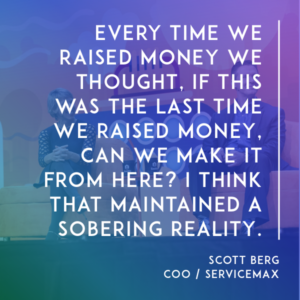
I think, every time we raised money we thought, if this was the last time we raised money, can we make it from here? I think that kept a sobering reality. Our CEO is a former tax auditor and accountant, so I think he’s a bit of a bean counter mentality, which…
Jason: Say that again because I think it’s super important. Every time you raise a round of financing, the mentality was this may be the last round.
Scott: If this was the last one, is this a good play? Do we know enough about ourselves? Is this enough money? This is the last one. Do we see how this story plays out? I think that kept us pretty healthy in going and getting money each time.
Jason: Why raise another round?
Scott: In our case, some of the timing was that capital was available and people were eager to invest. I guess I’ll say we were lucky enough in several of those rounds to have people approach us a little bit before we were ready with pretty decent terms that saw the momentum of our company.
That’s 2008 to 2016. That’s not today. I went through the dot bomb and calm and all the things before that too. It’s a little bit opportunistic in timing too.
Jason: SteelBrick, I think was similar, while there was clearly an intention of growing the business aggressively, there was a lot of inbound interest from investors which catalyzed those rounds.
Godard: Indeed. I think, together, we always raised before we needed to. It’s a good position to raise from, “Hey, we don’t really need it, but if you’re really interested,” and also give us a year of credit because otherwise, we won’t raise for a year.
It depends on the market environment, but certainly in 2014 and ’15, it was a good strategy.
Jason: Katy, obviously Lithium had a bunch of resources which it aggressively invested in marketing and sales. One of the things you did is made some acquisitions. I know one was very successful, one maybe not quite as successful.
Can you talk a little bit about, in retrospect, what lessons were learned from those strategic decisions and how you think about acquisitions for a company at that stage?
Katy: Yeah, I think it goes back to the unit economics and probably the category leadership.
I think as you go out and look to expand the portfolio of the offering, and I’m on the marketing side, so anything can be told together in a really good narrative, but the engine of our company was around how we build and grow big logos around the world.
Without naming each of them and all the details, the first acquisition tucked very nicely into the existing sales motion.
It wasn’t a massive acquisition from bringing in top line or accelerating the top line, but it did slip into the playbook in a way that said, “Hey, we’re going to this buying center and we’ve expanded the offering.”
The second one was more aspirational to the buying center we were moving to. It was seen as, I think, planting a flag but as a result, it takes longer for that success to materialize because you’re already struggling with that motion, so you’ve compounded that.
Jason: It’s a whole new motion, a whole new go to market with…
Katy: It’s a whole new motion and a business from $20 to $100 million, I don’t know what your guys’ experience is.
There was pieces of the business that were humming. You’re like, “OK, that trajectory looks right.” This one is a new buying center and it’s still clunky and we’re still pattern matching.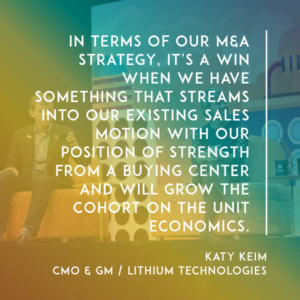
I think how it’s informed our M&A strategy is when we have something that slip streams into our existing sales motion with our position of strength from a buying center, and it will grow the cohort on the unit economics. That’s a win.
We can spin the category story and we will do fine on that part, but if we can’t materialize on the operating metrics, it’s going to take too long to deliver the return.
Jason: The adjacency, the closeness of the adjacency in terms of that buyer power is really…
[crosstalk]
Katy: Exactly, perfect way to say it. I think the second one was exactly where we’re going. I just think maybe we were a little ambitious of how fast we were going to get there.
Jason: Godard, was it Invoice IT, right? Got us a little bit of a foothold into the European market, but also it was an adjacent product that you thought, same buyer, same fundamental go to market strategies as well?
Godard: Yeah, I think similar to what Katy has said, but the idea was we were selling CPQ configure price quote. Some of our customers started saying, “Hey, I’d like to take it a step further. I’d like to generate invoices, collect cash,” what we call Quote to Cash now.
Invoice IT, like SteelBrick, was in the Salesforce ecosystem, so it was a small company, small product, but we thought we could sell it. That did work for us.
One other thing I wanted to mention, I wanted to go back to an earlier point Katy made which has some personal passion for me, but also about customer marketing, especially the analysts. That was always one frustration at BigMachines.
We started in 2000. I think we didn’t got into Gartner Report until 2008. The next one came out in 2011 but it was very lagging. It did inspire us. Right after BigMachines, I was involved in helping start a company called G2 Crowd and we actually use that also at SteelBrick for customer marketing.
The cool thing about G2 Crowd, part of the reason we started that, we didn’t want to wait Gartner or Forrester three years to write the report. With G2 Crowd, you get real time customer reviews, more like Yelp. I think that has become a pretty cool tool now for many SaaS entrepreneurs.
We use the G2 Crowd, frankly to deflect reference requests as the other challenge when you’re small, everyone wants to talk to your customers and on G2 Crowd there’s LinkedIn profiles, real customer reviews.
We said, “Hey go there first.” It both gave us validation quickly, and it gave us a way to deflect references. I think that’s another cool new tool that helped us grow faster the second time.
Jason: I’m not usually a huge fan of acquisitions but both your cases that actually turned out to be really good decisions for the company. We didn’t do one at ServiceMax, or a small one I guess, but not from a go to market perspective.
I want to transition from product, sales, marketing to building a great organization because our deep belief is that if you want to build an iconic company, you got to build a great company to work for and you guys have all come from amazing cultures. I wanted, if you could just articulate a little bit about both the management challenge of moving from 20 to 100?
Somebody mentioned Dunbar’s number when you don’t know everybody anymore. What are the management systems and culture that you put in place to help that transition to really a big company have a successful culture? Anybody want to…?
Scott: I’ll take it. I guess it starts with company principles and we were big on ours from day one. One of those principles is we only hire them if we love them.
No matter what management structures you put in place, and how you manage growth and all those things, if you start to bring people into the company that aren’t going to live up to the standard you’ve set early on, you can very, very quickly dilute and erode your base of talent and it’s really hard to recover.
This hiring them if we love them was like go beyond the resume, go beyond the profile. Yes, you checked references. There’s a lot of people that looked good at that level.
What’s that intangible thing that you say like, “This candidate’s here, don’t let this person leave. We’re making them an offer.” You know that moment. Make sure you’re hiring that moment, because you can’t…
Jason: It’s a chemistry thing or what is that?
Scott: I think it’s an intangible. It’s a fit with your culture. It’s somebody that can succeed.
I guess most importantly, you’re looking for somebody with all that skill set in a resume or CV. Can they apply it? Have they proven to me they can apply that experience? That’s that moment that you find yourself in when you’re interviewing people.
The other thing I’ll say is that, here’s the big phrase that a lot of people use about seeing around corners. As you go from 0 to 5 million to 10 million to 20 to 40 to 100, you’ve got to look around the corner and really ask yourself, “Do we have all the right talent that we need?”
You want to promote from within but we did a nice job of selectively bringing in some outsiders in advance of moments that we were going to be around a corner in a place that none of us had ever been in.
Jason: How do know, Scott? How do you know it’s time? That’s such hard thing. You work with these people. They join when you were young. They’ve put blood, sweat, and tears into growing the business.
Scott: It’s gut wrenching to say to that person. “Hey, it’s not going to be you. I have this other plan in mind, but here’s what I want you to do.” It’s a tough moment. I’ll say, I have to admit that you stumble a little bit before you realize, maybe you’re losing pace on something. Maybe you’re not quite hitting that next growth level that you want. You’re growing but it’s not what you need it to be.
Those are the signs that show up but it’s a tough call to say, “I can’t promote from within in this context anymore. I’ve got to bring in some outside talent,” and then how do you wrap your existing people around that talent?
Jason: You were able to keep a bunch of people that got so-called passed over, right?
Scott: I would say at least in my experience, I don’t think any of those people left and all those people ended up in really high value roles in the company going forward. We managed it well, but it’s a tough moment.
Katy: Jason, we have talked about somewhere around 20 million. I don’t know if it’s the right number but you go from — I call them cheap and cheerful. These are just athletes that do everything.
They’re not particularly well paid and they just can go everywhere with their boundless enthusiasm and their hustle to go into what I think is specialized hires in pivotal positions.
By pivotal, I mean like product marketing is going to affect everyone in product and everyone in the sales organization. That might be an area. I think we talked about FP&A. If you are going to a multi product strategy and if you’ve a rockstar in FP&A or sales ops, suddenly hundreds of people are humming because of those.
It was actually at ServiceSource. As a management team, we would go through and force rank the pivotal positions on the company and those were the ones that got funded first, which is, you guys know that’s not how budgets work. Usually it’s like, “I need seven. I need three.” Everyone’s fighting for their department.
I recently read an article this week by, I think it was HBR that said there’s only one in seven in your company that are going to be stars. Put your stars in those positions.
That’s a really interesting thing. Sometimes, you’ve got this awesome asset and you’re like, “If I move this person to product marketing, 25 more people would be awesome.”
Jason: I love this concept of the pivot position. It really came true when you talked about that. There’s one or two in every functional department that make everybody else better.
Katy: I think at 20 to 100, you start to have these conversations, like, “We need scale. We need people that have scaled.” I love that and you’re like, “OK, those people have no idea how to operate with a team of three and they’re going to lose their mind in the first six months,” because they’ve been running an organization this big.
Instead, I think it would be interesting to say like, “It’s not scale we’re looking for, it’s like power centers in these areas and we’re going to go pay for talent massively. Those people may have scaled or not, but they’re contagious.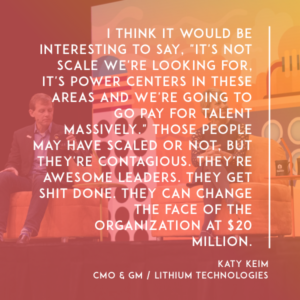
They’re awesome leaders. They get shit done. They can change the face of the organization at 20 million. I can think through both companies like, “When we hired that person, God, did that make a difference.”
Jason: Would you have done it earlier? How early can you recruit folks like that in what stage of the business?
Jason: I think as leaders, it’s our job to recruit those people as soon as possible into the right roles. Clearly comp is always a struggle between cash and equity. You got to give them a lot of room to move. I think it’s sometimes less about how big their team is. It’s like, “What’s their mandate, and why would they get excited about that?”
Yeah, I see it as the management team’s job to bring those people on and say, “You’re gonna go make this thing happen.”
Jason: Godard, you did something really interesting where you disaggregated traditional HR from, let’s call it, talent development. You actually hired somebody specifically in that role. Can you talk to us a little bit about that decision and what difference it made?
Godard: We really learned that the first time at BigMachines because I didn’t have it then. We had a leader in the company, Mei lin Cheng. She was a very seasoned experienced executive from HP.
Ultimately, she gravitated towards this role. As we started building SteelBrick, we realized, and traditional HR, I think, is more payroll setup, make sure people get their benefits, etc. but Mei lin, she was a special person. I used her even as a personal coach.
As we’re growing towards 100 people, to me it became a no brainer, where if you have one person just focused that everyone is well aligned with their career paths. She would facilitate workshops for different teams. We all started using the V2MOM even when we were a startup.
Obviously inspired by Marc Benioff and his book, but it just became a great alignment tool. Mei lin’s job, she would actually help me with my management team and each manager like the engineering team to find their own V2MOMs. She was also available as a coach because a lot of times myself or Matt would be too busy operating, not necessarily listening to our team that well.
Mei lin just became another person anyone could go to when they didn’t feel aligned with the company, when they were having struggles with their career. It was just phenomenal to see her just keeping us aligned, keeping the culture positive as we were running so fast.
Jason: What was her title exactly?
Godard: We called her VP of Professional Development.
Jason: VP of Professional Development.
Godard: That was really what she did. She didn’t have operational HR. That was under finance. She could just totally focus on developing people, helping us be better leaders, and helping us grow.
Jason: As always with a young company, lots of constraints. You’re always thinking of, “Do I absolutely need that person?”
Godard: Yes.
Jason: That sounds a little bit like a nice to have versus a must have. Do you agree with that assessment or no?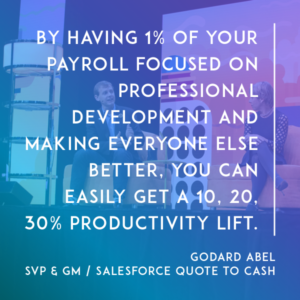
Godard: Yes, but on the flip side, like I said, let’s say $20 million. You’re probably driving 100 people, having one percent of your payroll focused on making everyone else better. I do easily think you get 10, 20, 30 percent productivity lift when everyone’s better aligned and feels comfortable in their role than if they’re not.
I think to me it’s a no brainer ROI, although a little harder to maybe justify.
Jason: Wanted to just wrap things up. We’re now between them and lunch, but it’s been a really fun panel to discuss these issues. There’s obviously an endless amount of topics that we could talk about.
I wanted each of you to leave some words of wisdom with the entrepreneurs in the audience about one or two key things that you think they should be thinking about as they scale their business.
Scott: I guess I’ll start. I think this notion of planning ahead a little bit. I think in early days in the company, you’re so busy doing what you’re doing every day that it’s really hard to pick your head up and look a little bit forward. You can’t just grind things out into a brick wall with your head down. You’ve got to think a little bit ahead of things.
I found us each year setting a plan and at least giving some thought as to where this could be in the following year. If you keep that lens, one eye, a little bit forward or out of the corner, your eye keep looking forward, you’ll make sure that you don’t just grind yourself [laughs] to a point of no return. You can see where the next step is going to come from.
Jason: Thanks, Scott.
Katy: I think mine goes back to the being intentional. If I had to say from $20 to $100 million, use what you have to identify patterns in the business. Make some bets on that, and then eliminate distractions, because in that stage, there are people that are like, “Oh, I don’t wanna constrain the TAM. I don’t wanna constrain my opportunity. Anyone could be a buyer.”
I think that level of that brutal focus to put some bets on what’s going to make you successful and avoid the distractions, that’s the brute force that can really get you from 20 to 100.
Godard: I think for me the difference between the first and second time, I would say is actually think less and…
Jason: Think less.
Godard: …just be more conscious. I had some great mentors through IPO…
Jason: It sounds very Buddhist.
[laughter]
Godard: I think it is. I think really being a successful entrepreneur is, to me, now less about the brain and more about the heart, just dialing into your own spiritual consciousness, and seeing where the natural flow of energy in the universe takes you. I think it really works.
Katy: Awesome.
Jason: I’ll just close it up by saying none of these folks built the companies they built because they got lucky. It was very, very intentional, and they were playing to win.
I’d encourage everybody, if you want to go for it, be intentional. Play to win, and build a great company not just great products.
You walk into these offices and you really feel the love, the emotion, and the spirit. Thanks for all your wisdom and advice today. Thanks for the audience participation as well.
[audience]
Godard: Thank you, Jason.
Katy: Thanks, Jason. Thanks, Scott.

